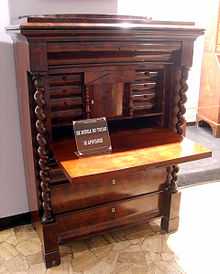Chiffonier

A chiffonier (or cheffonier) is a piece of furniture differentiated from the sideboard by its smaller size and by the enclosure of the whole of the front by doors. Its name (which comes from the French for a rag-picker) suggests that it was originally intended as a receptacle for odds and ends which had no place elsewhere, but it now usually serves the purpose of a sideboard.
It was one of the many curious developments of the mixed taste, at once cumbrous and bizarre, which prevailed in furniture during the Empire period in England. The earliest chiffoniers date from that time; they are usually of rosewood - the favorite timber of that moment; their furniture (the technical name for knobs, handles, and escutcheons) was most commonly of brass, and there was very often a raised shelf with a pierced brass gallery at the back. The doors were well panelled and often edged with brass-beading, while the feet were pads or claws, or, in the choicer examples, sphinxes in gilded bronze.
References
 This article incorporates text from a publication now in the public domain: Chisholm, Hugh, ed. (1911). Encyclopædia Britannica (11th ed.). Cambridge University Press
This article incorporates text from a publication now in the public domain: Chisholm, Hugh, ed. (1911). Encyclopædia Britannica (11th ed.). Cambridge University Press
| Wikimedia Commons has media related to Chiffonniers. |